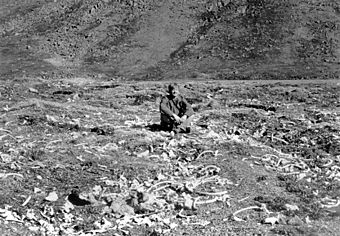Gambell Sites facts for kids
|
Gambell Sites
|
|

One of the Gambell Sites
|
|
| Lua error in Module:Location_map at line 420: attempt to index field 'wikibase' (a nil value). | |
| Location | Address restricted , St. Lawrence Island, Alaska, USA |
|---|---|
| Nearest city | Gambell, Alaska |
| NRHP reference No. | 66000160 |
Quick facts for kids Significant dates |
|
| Added to NRHP | October 15, 1966 |
| Designated NHL | 1962 |
| Delisted NHL | January 13, 1989 |
The Gambell Sites are five special places on St. Lawrence Island in Alaska. These sites are important because they show us how people lived there for over 2,000 years. Archaeologists study old things found in the ground. They use these finds to learn about the past.
These sites helped experts create a timeline of human life on the island. The sites are named Hillside, Mayughaaq, Ayveghyaget, Old Gambell, and Seklowaghyag. They tell us about the Thule people, who were ancestors of today's Inuit people.
Contents
Discovering the Past
Archaeologists first started digging at the Gambell Sites in 1927. They found many clues about ancient life. These clues helped them understand different periods of the Thule culture. Each period shows how the people's way of life changed over time.
What is Thule Culture?
The Thule people were skilled hunters and gatherers. They lived in the Arctic regions. They were very good at adapting to cold environments. Their culture included unique tools, homes, and traditions. The Gambell Sites show how their culture developed.
Important Discoveries
The sites gave us evidence of four main cultural phases. These phases are like chapters in a history book. They show how the Thule people lived, hunted, and built things. Many items made from ivory were found. Ivory comes from animal tusks, like walruses.
Protecting History
Because the Gambell Sites were so important, they received special recognition. In 1962, they were named a National Historic Landmark. This means they are a place of great national importance. It helps protect them for future generations.
National Register of Historic Places
When the National Register of Historic Places was created in 1966, the Gambell Sites were added to it. The National Register lists places that are important to American history. This list helps keep track of valuable historic sites.
Why the Landmark Status Changed
Over time, the archaeological value of the Gambell Sites changed. People from the local area began digging up the buried ivory. This was done to sell the ivory. While this provided income, it also damaged the historical layers of the sites.
Because of this damage, the Gambell Sites lost their National Historic Landmark status in 1989. This means they were no longer considered a "landmark." However, they are still listed on the National Register of Historic Places. This still recognizes their historical importance.

